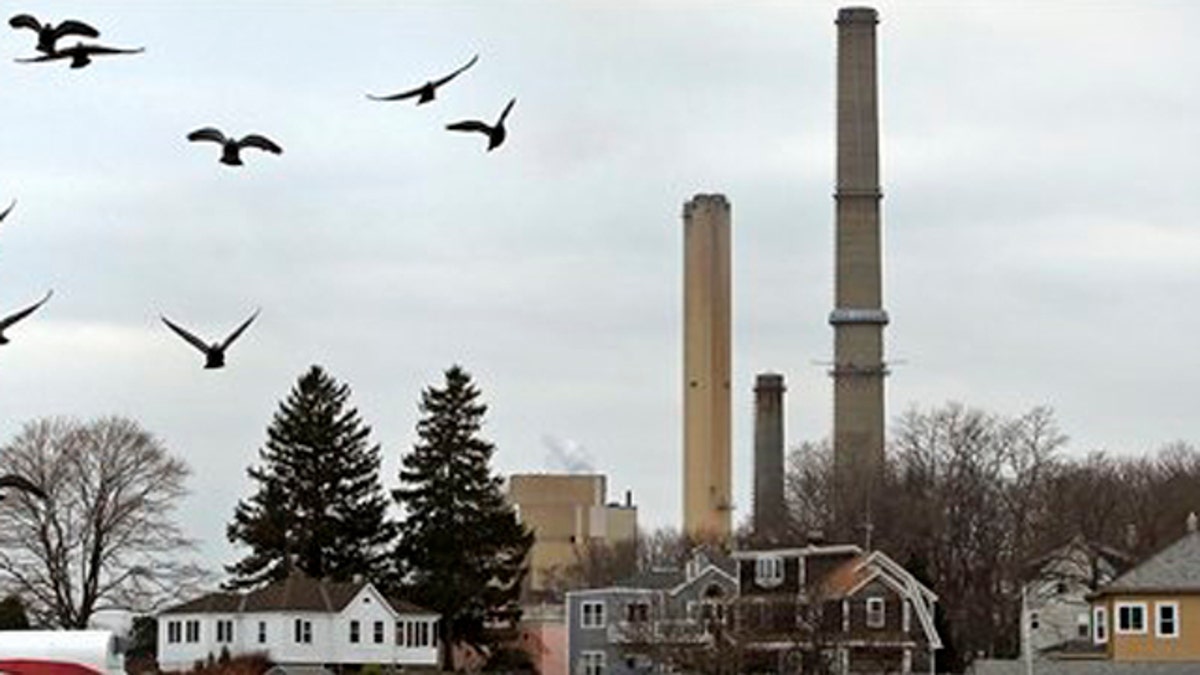
December 14, 2011: Pigeons fly past as the stacks of Dominion's power plant tower over a nearby neighborhood in Salem, Mass. (AP)
For more than 90 years, the coal-fired power plant in Glen Lyn, Va., has been churning out electricity and contributing to local prosperity. Of late, it has generated nearly a quarter of the revenue for the $1 million budget of the town.
Yet when the plant ultimately shuts down to comply with new federal air pollution regulations by the end of 2014, says Town Manager Howard Spencer, so too might the community of 200.
"If the town lost all of that revenue," he says, "we would struggle to even continue to be incorporated."
An Associated Press analysis has found that more than 32 mostly coal-fired power plants in a dozen states will be forced to close because of the new, more stringent regulations. Another 36 plants are at risk of closing.
No lights will go dark. But the Environmental Protection Agency has estimated that 14.7 gigawatts -- enough power for more than 11 million households -- will be retired from the power grid in the 2014-15 period when the rules take effect. One rule curbs air pollution in states downwind from dirty power plants. Another sets first standards for mercury and other toxic pollutants from smokestacks.
The effect is greatest in the Midwest and in coal belt states such as Virginia and West Virginia, where dozens of units are likely to shut down.
Take Giles County, where American Electric Power's Glen Lyn plant is located, and where 44 jobs are on the line.
County Administrator Chris McKlarney worries about the $600,000 tax-revenue hit his $40 million budget will take. But that's just one concern involving a plant and workers whose community contribution is "hard to quantify."
"They've done so much donation-wise for local causes ... And they're really good people working there," he said. "They're coaches in Little League sports, involved in the Parent-Teacher Organization -- you lose those kind of people, it's tough."
And they're good jobs -- stable, well-paying positions with good benefits in places where such things can be hard to find.
The closures, though, have long been anticipated. The average age of the plants that could be sacrificed is 51 years.
Many plants, such as the one in Glen Lyn, began ramping down production more than a year ago, firing up only when demand surged. Many workers have transferred to more modern plants or are making plans to retire.
To be sure, there will be pain. The smaller the community, the deeper it's likely to be felt. Tax revenues will drop, and communities will struggle to make up the difference.
In Rivesville, W.Va., where Ohio-based FirstEnergy is closing an old plant, the slow death began long ago. Mayor Jim Hershman, who worked at the plant for 25 years before retiring, says it had about 40 employees until a year ago when most transferred out.
Few of the 10 left even live in the north-central West Virginia community of 1,200, Hershman says. The town stands to lose $40,000 in utility tax revenue -- one-fifth of its total budget.
On the surface, the loss of 60 jobs at AEP's Kammer Plant near Moundsville, W.Va., may also seem small, said City Manager Allen Hendershot. The plant is outside the limits of the city of 9,000, so it has no direct impact on the budget. Yet there's a trickle-down effect on companies that supply materials and services for its day-to-day operation.
"It's hard to put an exact number on it," Hendershot says. "It's the coal mine jobs, the trucking jobs, the maintenance jobs."
Utility bills are certain to rise as plants go offline and others are retrofitted to meet the new regulations.
But the lights will stay on.
"It won't be like you're just pulling a plug out of the wall at those plants and they'll instantly shut down," said Brian Bretsch, a spokesman for St. Louis-based Ameren Corp.
That company, for instance, plans to finish mothballing plants near Hutsonville in eastern Illinois and Meredosia on the other side of the state by next spring.
Most of the 90 Ameren employees affected have already agreed to relocate, Bretsch said, and many others are retiring.
Roger Eddy, superintendent of the Hutsonville district schools and a Republican legislator, said he expects to recoup at least some lost revenue from the state. Farmland, commercial or residential property owners might face higher taxes, too.
"When this came out, people here were really like, `This is going to kill the school district.' It won't," Eddy said.
"I don't see any destitution coming from this," agreed Hutsonville Township supervisor Mike Gray.
Ameren still owns the property, and it will continue to generate property tax revenue for the community of 1,800. At least, he said, until someone challenges that.
In Hammond, Ind., where the State Line Power Station on Lake Michigan near Chicago is scheduled to close March 31, Mayor Tom McDermott Jr. has mixed feelings.
Like other community leaders, he worries about job losses, the effect on vendors and higher electric bills for people who can barely afford to keep their heat and lights on now.
But State Line is one of the dirtiest coal plants in the United States, "and it's in our backyard," he said. "I understand we need to move forward and we need to clean up our environment."

